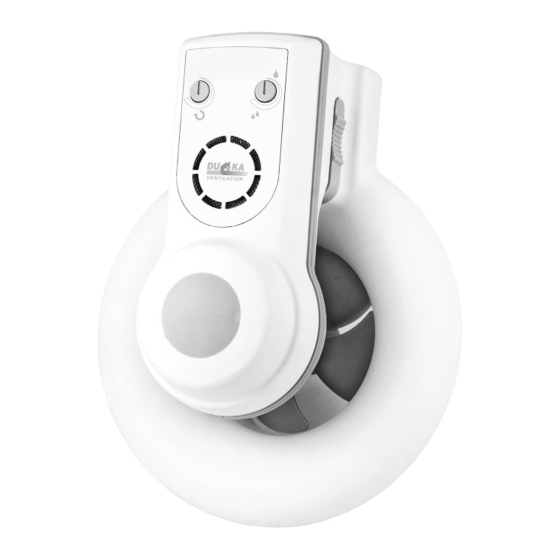Duka PRO 260 User And Installation Manual - Page 9
Browse online or download pdf User And Installation Manual for Fan Duka PRO 260. Duka PRO 260 11 pages.

UK - to the user
Before using the fan, carefully read these instructions and the warranty conditions.
PRO 260 is designed for fixed installation and must be installed by a qualified electrician.
All the illustrations referred to in the text can be found on page "III". Fold the page out to the
left so that you can see the illustrations while reading the user guide.
The PRO 260 exhaust fan is designed to boost the air flow in houses* with natural draught ventila-
tion. It is suitable for installation in wet rooms and can be installed in ducts with and without natural
ventilation**.
The fan fits ducts with a diameter of Ø or 100 – Ø 140 mm. For larger duct dimensions a cover
plate for the PRO-series must be used. To ensure that the PRO 260 does not affect other ventilation
systems and is not affected by them, the fan must always be installed in its own duct. Make sure that
the duct is clear of obstructions. Avoid insect mesh, filters and other objects that may obstruct the
flow of air. To prevent condensation in natural draught ducts (in winter), the ducts must be insulated
where they pass through unheated areas such a cold attics.
To avoid backdraughts in ducts without natural draught (eg through an external wall), a back-
draught shutter (see page II) can be retrofitted. This requires another ventilation system to handle
the basic ventilation flow of the building. NOTE: A backdraught shutter is harmful if the fan is
installed in a ventilation duct with natural ventilation.
The fan is designed for use in a temperature range of 5 to 35 °C. If the fan is installed in a cold area
or if it has been stored in a cold place before installation, it may run slowly when started for the first
time. The fan will work normally when it reaches its working temperature.
Make sure that air can enter the bathroom, for example through a large gap at the door or by using
a transfer air unit. We recommend the use of genuine accessories (see page II) to ensure that the fan
works properly and delivers the correct capacity.
* Primarily detached houses and holiday homes, but can also be used in multi-dwelling
buildings with separate, short ventilation ducts.
** With natural draught ventilation, air is carried upwards through ventilation ducts and
out of the building (see page 15). For natural draught ventilation to work, the air inside
the building must be warmer (and therefore lighter) than the air outside.
Natural draught ventilation therefore works best during the winter. Natural draught
ventilation will be reduced or absent if the temperature differential (inside/outside)
is small or non-existent. For this reason, buildings are often poorly ventilated when the
weather is warm.
FunCtions – settings
Speed control (see Figure C)
The fan has a function for stepless control of its basic speed, from about one-third speed up to
maximum speed (C1). Running the PAX passad 60 continuously at a basic speed ensures air turnover
all year round.
Suggested settings:
• in winter, about one-third speed.
• in spring, summer and autumn about two-thirds speed.
10
Humidity control (see Figure C)
If the humidity goes high, a built-in humidity sensor increases the speed of the fan from basic speed
to maximum speed. The area where the fan is installed must be dry when you set the point at which
the speed increases. First turn the control (C2) clockwise until the fan is running at full speed. Then
slowly turn the control anticlockwise until the fan switches back to low speed. The fan is now set. It
will now change to full speed when the humidity goes above the set level
Switch-controlled timer function
Important: Inform your electrical installer before the installation work starts if you want any of the
functions below, since they require electrical wiring to a separate switch or light switch.
The built-in electronics of the fan include a timer function.
- When the light in the room (or a separate switch) is turned on, the speed increases from
basic to maximum.
- When the switch is turned off, the fan runs at maximum speed for 15 minutes
(timer function). The fan then returns to its basic speed***.
There is also a facility to start the fan immediately at full speed:
- When the separate switch or the light switch of the room is turned on.
- When the switch is turned off, the fan returns to its basic speed***.
*** The fan will only return from maximum speed to its set basic speed if the humidity in the room
is below the set level (see the section on humidity control above).
Cleaning
For the fan to keep working and maintain its capacity it must be cleaned at least twice a year and
more often if necessary.
• Disconnect the fan from the electric power supply before cleaning it.
• Push the two locking buttons towards the centre (A1) and lift the motor unit out of
the frame (see Figure A). Then remove the motor unit (A2).
• Clean the opening, the duct and the motor unit with a damp cloth (a mild detergent
may be used if necessary).
• The impeller can be cleaned in place. If the impeller is very dirty you can remove it by pulling
it straight out (see Figure B). It can then be washed and rinsed.
(To avoid rust, allow the impeller to dry before refitting it to the motor shaft.)
• Do not use solvents on the fan.
• Do not immerse the fan in water or flush water jets on it.
environMent
A fan that is no longer serviceable should be recycled as electronic scrap.
UK - to the user
11
